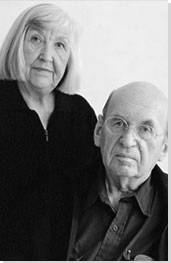Hilla Becher was born on the 2nd of September, 1934 in Potsdam, Germany. She passed away on the 10th of October, 2015 in Düsseldorf, Germany. Bernd Becher was born on the 20th of August, 1931 in Siegen, Germany and he died on the 22nd of June, 2007 in Rostock, Germany. They began collaborating together in 1959 after meeting at the Kunstakademie Düsseldorf in 1957. Bernd originally studied painting and then typography, whereas Hilla had trained as a commercial photographer. After two years collaborating together, they married.
The husband and wife team of Bernd and Hilla Becher began photographing together in 1959. Bernd and Hilla Becher documented architectural forms referred to as “anonymous sculpture” for over thirty years. Their extensive series of water towers, blast furnaces, coal mine tipples, industrial facades, and other vernacular industrial architecture comprise an in-depth study of the intricate relationship between form and function. Many books on their work are in publication, each titled after the industrial structure that they document.
They always made sure their photographs consisted of capturing the building during a grey, soft- lighted day, which resulted in them creating a form of photography arranged by type that, through repetition, encourages viewers to engage deeply with the formal qualities of the subject matter. Bernd and Hilla Becher aspired to direct the audience’s attention away from the photograph, emphasizing the content rather than light, perspective, or other artistic choices, but in doing so created a school of photography that forced reconsideration both of the presentation of images and the preservation of the built environment.
Some people even referred to their work as sculpture, however the couple made it clear that although it was architecture, their work was photography.
“You have to be honest with your object and to make sure you do not destroy it with your subjectivity, and yet remain involved at the same time“
– Hilla Becher

Image Analysis

This is one of the typologies created by the Bechers, a sequence of 15 photographs of spherical gasholders placed into a grid. The grouping of the gas tanks, causes the audience’s attention to be attracted by the piece, the photos focussing on the strained, round appearance of the structures contrasting with the differently positioned skeletal staircases wrapped around the tanks surface. This encourages analysis of the way the staircases differentiate the structures from one another, without interfering with the function they have as well as the look of the images being grouped together, since each picture links in with all the others, creating a sense of a repeated pattern. This is something that Hilla and Bernd Becher focusses on when taking each photo- they wanted each photo to have the same composition and overall appearance, with small details indicating that each shot is different. The way the Bechers intertwined the idea of typology in their work is very clever- presenting the structures as though they are scientific specimens and therefore showing no indication of their own conclusions regarding the gas tanks and their impact on the world. The way they put all of their photos into a grid is very effective, causing the audience’s attention to be evenly distributed between all of the images. Each photo appears to have been taken at the same time, during the same weather, creating a sense of timelessness in the photos. The bleak, dull sky causes each structure to stand out, another aspect that was clearly important to the photographers. Moreover, the individuality of each structure is stripped away as they are presented as a group, causing them to appear as examples of a type rather than individual structures which don’t express the creativity of their designers.
